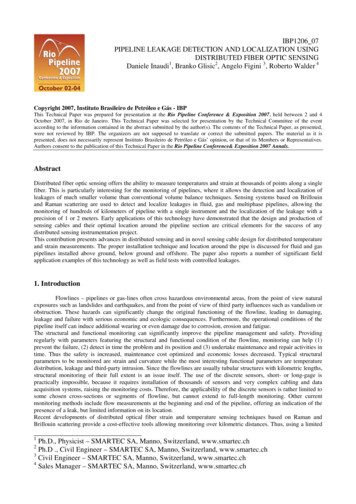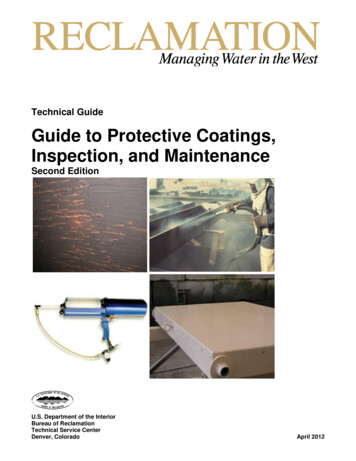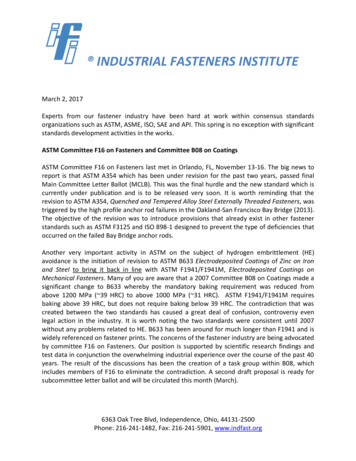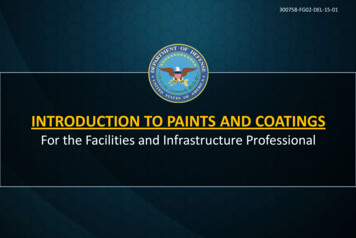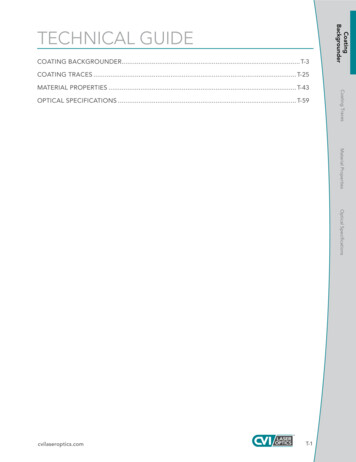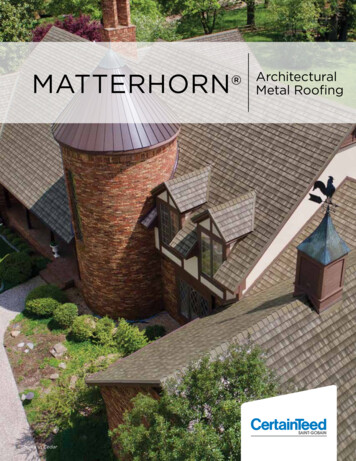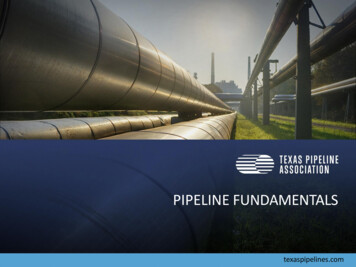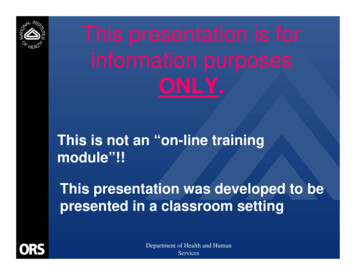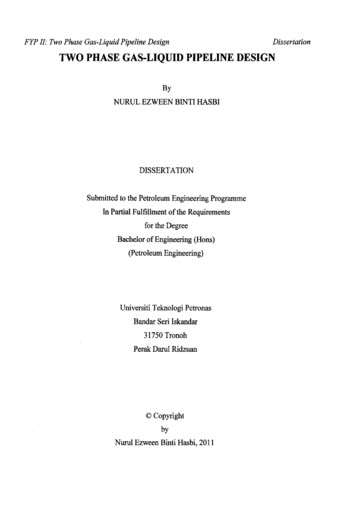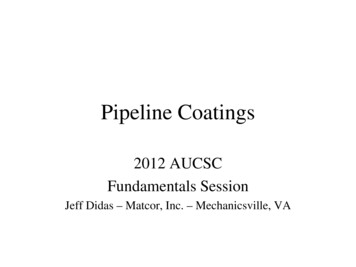
Transcription
Pipeline Coatings2012 AUCSCFundamentals SessionJeff Didas – Matcor, Inc. – Mechanicsville, VA
Remember This! Coatings are the #1 defense againstcorrosion. This is true for underground, transition andabove ground service.
Coating Types Underground – buried or immersion serviceTransition area coatingsAtmospheric coatingsInternal coatings & linings
Underground Pipeline Coatings Mill or Plant AppliedField AppliedLine CoatingsRepair CoatingsCoating DiscussionCoating CostCoating Quality
Mill or Plant Applied Most economical method to apply coatings Highest level of quality and quality control Plant/Mill conditions allow use of higherperforming coatings Normally, high quality storage, handlingand shipping Normally allows for some coated pipestorage
Field Applied Costly method either over the ditch or in theditch Hard to manage quality control due toenvironmental conditions Normally lower performing coatings Newer field coatings do allow higherproductivity
Line Coatings Coal Tar EnamelAsphalt EnamelExtruded PolyethyleneFusion Bonded EpoxySomasticPritecLiquid Epoxy3 Layer
Repair Coatings TapesWaxShrink SleevesTwo - Part EpoxyMasticMisc.
Coatings Discussion Most important component of a pipeline High quality holiday free coating requiresalmost no cathodic protection current Coatings need to be specified Coatings need to be tested Every coating has a use, but most coatingsare used improperly – follow procedures
Coating Cost Cost of materialCost of applicationCost to repairHandlingExpected lifeDielectric strength
Coating Quality Quality determines price Quality is normally dependent upon surfacepreparation & application methods Quality is assured with competentinspection Quality is determined by good proceduresand good specifications
Transition Area Coatings Used where piping transitions from buriedservice to atmospheric service Used to protect from mechanical damage –freeze/thaw cycle, weed whackers, gravel,etc. Used to protect buried service coatings fromUltraviolet light when used above ground
Atmospheric Coatings Various types, quality and expected life Primary purpose is corrosion prevention,secondary purpose is appearance Problem areas, flanges, nuts, bolts, holddown clamps, high temperature service,beneath insulation, throughwalls/foundations, etc.
Perfect Coating Ease of Application - It can be applied with amop on any surface or from above ground. Cost Effective - Cost 1.00/Gallon or less! Environmentally Safe and Friendly – OK toDrink it. Performance - Lasts forever.
In Reality a Perfect Coating Requires a quality standardRequires a quality specificationRequires a quality coating millRequires a quality material or materialsRequires a quality inspector or inspectors
Line Pipe CoatingProcess
INTRODUCTIONThis slideshow steps you through theprocess of Mill-Applied external thin film(FBE) coating. The guideline for thisprocess is set forth in NACE SpecificationRP0394-94.
The pipe enters the mill and is ready for theabrasive blasting procedure.
The pipe enters the pre-heat oven where itstemperature is raised to approximately 130degrees. It then enters the abrasive blastingbooth.
The pipe exits the blasting booth with anear-white surface finish and the requiredanchor profile.
At this stage, the blasted pipe surface ischecked for raised slivers, scabs,laminations, or bristles which are removedby file or abrasive sanders. A coupler isthen inserted into the end of each joint ofpipe.
The coupler is used to connect and seal twojoints of pipe together, so one pushes theother through the rest of the process.
Two pipe joints joined with coupler.
The pipe then enters an acid bath to removesurface contaminants.
After the acid bath and rinse, the pipeenters a series of ovens that raise thetemperature of the pipe to approximately475 degrees before application of thecoating.
Pipe entering last oven before coating.
The joint between pipes is covered, so thatthe ends of each joint are left free ofcoating. This is done to allow welding inthe field.
The pipe exits the coating booth where jetshave applied a coating to the hot pipe withan average coating thickness of 15 mils.
The tape around the joint is now removedand pipe continues to the quenchingchamber.
In the next step of this process, the pipeenters a quenching chamber and is watercooled to around 250 degrees.
Pipe coming out of quenching chamber.
Stencil being added to pipe stating thecompany name, API information and sizeand wall thickness of pipe.
Company Inspector verifying that thecoating thickness is acceptable.
Ropes are put around pipe to keep joints ofpipe separated and to prevent coatingdamage.
A 2,000 volt , nonpulsating, low ripple DCdry-type holiday detector is then used todetect any holidays that may exist in thecoating.
Repair of a pinhole size holiday in thecoating. Patching with these touch up sticks isonly allowed in the mill while the pipe is stillhot. Preheating the pipe properly is thelimiting factor for field application.
Holiday repair using touch-up sticks.
Each pipe is measured and given a number.
The pipe is then carried into the yard. Theforklift has protective padding on the jaws.
The pipe is stacked with padded boardsbetween them to prevent damage to thecoating.
The joints of pipe are unloaded on to thepadded boards and the ropes separate thejoints and protect them from damage whenstriking other pipes.
The End! Questions?
Coating Types Underground - buried or immersion service Transition area coatings Atmospheric coatings Internal coatings & linings . . The pipe exits the coating booth where jets have applied a coating to the hot pipe with an average coating thickness of 15 mils.

